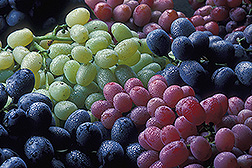Science Update
Portion of Plant Enzyme May Mimic Taxol
Researchers interested in increasing plant cells' use of carbon for seed storage products like starch, oil, and protein have been studying sucrose synthase. This enzyme metabolizes sugar and delivers carbon for plant cell growth and other uses. As a tool, the scientists fashioned a synthetic peptide, called SS2, from a portion of the enzyme. They used SS2 to identify regions of sucrose synthase that bind to actin, a filamentous protein that's part of the cytoskeleton used by plant cells when dividing and elongating.
They found that SS2 caused actin filaments to clump together—or bundle—which stopped plant cells from dividing. Bundling is similar to how taxol checks the spread of some human cancer cells. A patent has been filed for SS2, and a licensing partner's being sought to investigate the peptide's potential medical applications.
Steven C. Huber, USDA-ARS Photosynthesis Research Unit, Urbana, Illinois; phone (217) 265-0909.
While chicken eggs are best known for their high-quality protein and widespread use in bakery and other food products, they are also an excellent source of lutein. Low lutein intake has been implicated as a risk factor in age-related macular degeneration, the leading cause of vision loss among older Americans. The macula is located in the retina, behind the pupil, and is responsible for central vision. Lutein and another carotenoid, zeaxanthin, accumulate within the macula and impart a yellow pigment that helps protect the eye.
Now scientists have found that the lutein present in eggs is more readily absorbed into the bloodstream than lutein from other sources—possibly because of components in the egg's yolk, like lecithin. Their research showed that the concentration of lutein in volunteers' blood serum was three times greater after eating eggs than after consuming the same amount of lutein from other sources, including cooked spinach and two types of lutein supplements.
Elizabeth J. Johnson, Jean Mayer USDA Human Nutrition Research Center on Aging at Tufts University, Boston, Massachusetts; phone (617) 556-3204.
No one has really understood how plants orchestrate quick, protective responses to pest attacks, wounds, and other stresses. Now a simple, accurate method has been devised that uses readily available chemicals, standards, and instruments to shed light on these processes. The new protocol simultaneously analyzes interactions between multiple plant hormones, fatty acids, pathogen-derived elicitors, and other volatile organic compounds.
The method gives physiologists a rapid way to examine how plants use complex phytohormone interactions—called "signaling crosstalk"—to coordinate growth, development, and dynamic responses to stress. It uses vapor phase extraction techniques to collect the phytohormones and other metabolites from just a few milligrams of plant tissue, gas chromatography to separate components within the sample, and mass spectrometry to analyze and measure target compounds.
Eric A. Schmelz, USDA-ARS Center for Medical, Agricultural, and Veterinary Entomology, Gainesville, Florida; phone (352) 374-5858.

Grapes.
(K3681-16)Lower Your Lipids—With Grapes
Recent research using rat liver cells suggests that a compound in grapes called pterostilbene (TAIR-oh-STILL-bean) can help people reduce their lipid levels. The study found the lipid-lowering property of pterostilbene to be superior to that of resveratrol, another beneficial compound found in grapes, as well as to ciprofibrate, a commercial hypolipidemic drug.
This novel study showed how, at cellular and molecular levels, resveratrol and similar compounds activate a biological receptor that regulates fatty acid metabolism and plasma lipoproteins, helping prevent plaque deposition in arteries. Other research detected, for the first time, pterostilbene in a genus of shrubs—Vaccinium—that includes blueberries, lingonberries, and huckleberries.
Agnes Rimando, USDA-ARS Natural Products Utilization Research Unit, Oxford, Mississippi; phone (662) 915-1037.
"Science Update" was published in the March 2005 issue of Agricultural Research magazine.






